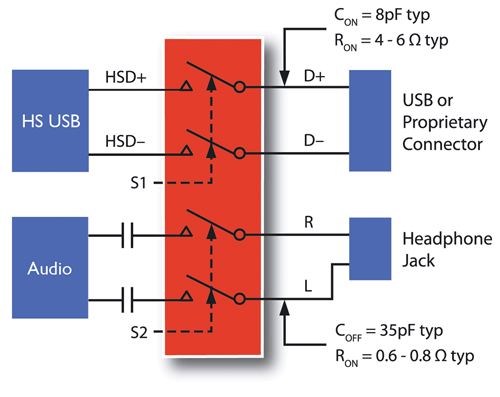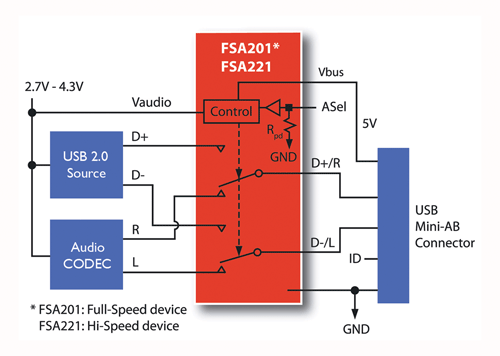From USB2.0 and audio switches to multimedia
Design trends abound for ultraportable applications
BY GRAHAM LS CONNOLLY
Fairchild Semiconductor
South Portland, ME
http://www.fairchildsemi.com
Features, features, and more features! That is a theme that has emerged in the ultraportable market in the last few years. There is now a natural migration for multiplexing audio and data sources onto the USB data cable. With the addition of video/TV there also is a need for multimedia switches that are optimized for each of these data sources (MP3 players, portable media players, and mobile TV cell phones).
USB-optimized switches provide the preferred solution for this data-path signal routing. Audio and USB paths present different, mutually exclusive characteristics to consider, including negative-swing audio. Combining each of these paths and maintaining good signal integrity and performance is an interesting challenge.
Good design techniques differ according to several factors, including whether the application is high speed (HS: 480 Mbits/s) or full speed (FS: 12 Mbits/s); whether audio data is negative swing; whether video is streaming (real time). Next-generation switches that are optimized for the different data path characteristics (USB, audio and video) and yet reside in a single package are ideal for these multimedia applications.
Let us begin with the USB and audio data paths since one of the most common trends is the ability to download music into our MP3 player/cell phone. Initially FS USB2.0 was used, but our desire to download faster or more soundtracks resulted in the HS USB2.0 data transfer migration.
Combining USB2.0 and audio data paths
Figure 1 shows an older-generation architecture where the USB2.0 and audio paths are kept separate and the interface to the external world is via independent signal pins, perhaps via a proprietary connector. This architecture was adequate for a long time, but as more features were squeezed into our ultraportables, the need emerged for the multiplexing of data paths.

Fig. 1. An older-generation architecture where the USB2.0 and audio paths are kept separate and the interface to the external world is via independent signal pins
For audio applications THD RFLAT (RON flatness) and a low RON is preferred (0.3 to 0.6 Ω). These criteria can potentially lead to a high CON that impacts the HS USB2.0 data transfers. The values for CON , COFF and RON shown in Fig. 1 are typical characteristics for some switches of the older generation products in the marketplace.
In the case of USB2.0 the CON is the more dominant factor so CON should be kept as low as possible for high speed USB2.0 data transmission, preferably less than 6 to 7 pF max. Keeping this capacitance low ensures that the USB-IF eye compliance is met.
It also means that care is needed when arbitrarily adding external ESD (or TVS) components, which can be very capacitive. To meet this eye diagram the RON can be higher to reduce the capacitance but the tradeoff is headroom to the USB2.0 eye diagram. It is important to allow for the insertion loss characteristics that naturally occur when adding the switch between the controller and connector.
When sharing connector pins optimize for USB2.0 and minimize compromising the audio path dynamic characteristics. Modifying Fig. 1 to share connector pins results in the capacitance seen by the USB controller to be CONUSB + COFFAUDIO (43 pF), which dramatically impacts the high-speed eye diagram, possibly to the point of failure. A tradeoff has the audio path RON relaxed (2 to 6 Ω typ) while maintaining CONUSB around 5 to 6 pF.
The audio RON should not be relaxed too much to minimize the attenuation or power transfer loss of the signal through the switch. Design techniques such as charge-pump circuits, to lower the RON for a smaller CON -sized device, exist. They are not always beneficial for ultraportable applications since there is often an increase in power consumption (300 to 800 µA) by adding the charge pump. Fairchild Semiconductor’s USB/audio switches contribute less than 1 µA of quiescent supply current to the power budget while maintaining the USB2.0 USB-IF eye compliance.
Added features
Another trend in the ultraportable design is the desire to not require dc-blocking capacitors (typically 220 µF in a 32-Ω headphone environment) in the audio path. To remove these capacitors, saving part cost and PCB real estate, requires the ability for the audio path to handle negative-swing signals.
Historically, audio amplifiers are single-supply referenced with a typical dc bias of VCC /2, which is removed by the dc-blocking capacitors to minimize wasted power into the speaker. The advent of amplifiers, with internally generated negative supply rails (via a charge pump), have led to the ability of removing the dc-blocking capacitors.
These capacitor-free headphone drivers are becoming more popular ,and there is an increase in the power transfer capability to the speakers with negative-swing audio amplifiers and negative-swing analog switches.
Negative-swing capability offers a better frequency response down in the 20-Hz range of the audio spectrum. This is accomplished as the capacitor no longer forms a high-pass filter with the speaker load and the bass performance is enhanced.
The dc-blocking capacitors are also a source of click and pop as they are charged and discharged simultaneously with the audio amplifier being turned on or off. Pop and click can be reduced under software control, or discharging the nodes to a fixed known potential but negative-swing switches eliminates the need for these solutions also.
When combining a negative-swing audio path and a USB2.0 path the designer becomes aware of maintaining the isolation between the two sources. Today’s negative-swing audio switches are designed to allow for 2-V swing to ensure that there is no possibility of the switch silicon clipping the audio signal while maintaining isolation to the USB2.0 source. In the combination of USB2.0 and audio it may be advantageous to automatically detect when the consumer has a USB cable connected versus a headphone.

Fig. 2. In the combination of USB2.0 and audio it may be advantageous to automatically detect when the consumer has a USB cable connected versus a headphone.
In many ultraportable applications when a USB2.0 cable is connected, the product will most likely be a bus-powered peripheral, unless an OTG (On The Go) peripheral and VBUS is available. Detecting this connection and automatically configuring to the USB2.0 data path functionality is just what the Fairchild Semiconductor FSA221 switch does (see Fig. 2 ). Where the device is self-powered, switching between USB2.0 and audio is facilitated via the ASEL pin.
Adding video (or TV)
Cell phones with cameras and MP3 players are now common in the market, and next-generation phones are beginning to integrate live TV. Consumers now want to watch live sports events (Olympics or World Cup Soccer) on the road. They want both to communicate and be entertained.
Estimates for DTV (Digital TV) enabled cell phones project 100MU+ by 2009. The most common (open) standards include DVB-H (Digital Video BroadcastHandheld; US and Europe), DMB (Digital Media BroadcastKorea) and ISBT (Integrated Services Digital Broadcast-Terrestrial; Japan).
These standards are also beginning to migrate to other regions of the world. Again, minimizing device count and multiplexing these different formats is advantageous. Fairchild Semiconductor’s FSA203 is such a device that combines USB2.0, audio and video (including video filter). Multimedia switches are here to stay and provide tremendous value to the applications they serve. ■
For more on multimedia, visit http://electronicproducts-com-develop.go-vip.net/linear.asp.
Advertisement
Learn more about Fairchild Semiconductor





